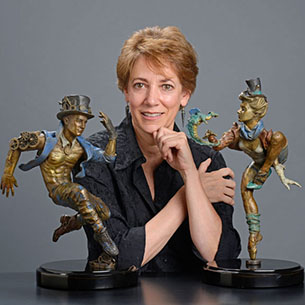Biography
Lorraine Vail is recognized for her intricate, mystifying bronze sculpture with unexpected and challenging shapes in her figures. In her beautiful new studio environment, architecturally designed by Vail, she works in wax-based clay and subsequently works with the foundry to cast the pieces in bronze using the ancient ‘lost wax’ method of casting. With no particular boundaries, she creates unpredictable beings, seemingly at times drawn from Western or mythological folklore. The spontaneous form of mystical figures intrigues the artist and our inner mind often seems to dwell in the subtle places that Vail invents. The newest works continue to challenge us in many intriguing ways with her inventive use of ether world creatures.
An apprentice in the studio of a noted painter starting at the age fifteen, Lorraine Vail’s solid traditional background in drawing and painting earned a full, four-year scholarship based on artistic merit. With a B.F.A. in Illustration from the University of the Arts in Philadelphia, PA she then worked as a freelance illustrator and sculptor primarily in New York and Philadelphia.With an exceedingly active, twenty-year history of public sculpture commissions, Vail’s work can be found in a number of public and private collections in this country as well as overseas, where several distinguished hotels have installed her fountains and sculptures.She has been honored with a number of solo and group exhibitions and her work appears in a variety of venues from galleries and museums to corporations and universities. Her sculptures have appeared in exhibits at Temple University, PA. They are part of the permanent collections of the Blackhawk Automotive Museum in CA and the Berman Museum in PA. Three of Vail’s public sculptures are listed as sites on the National Museum of Women in the Arts tour in the Washington, D.C. area. Five of Vail’s bronzes are included in the Vatican Library’s permanent art collection in Rome.
Southwest Art magazine
Lorraine Vail describes the process of bringing an artistic idea to fruition as being similar to dreaming. “Often an idea will form in my mind, and it’s completely visual—I don’t immediately know the significance or meaning behind it,” she says, explaining that it’s not until that vision is transferred into material form (usually by sketching it out on paper) that she begins to understand what it’s about. “It’s like recalling a dream and suddenly realizing, ‘Oh, that was really about power, or beauty, or something entirely different than you originally thought,’” she says.For Vail, the potential for limitless interpretation is one of the most exciting aspects of art. Whether she is translating her vision onto canvas or forming it into the imaginative bronze figures she’s best known for, Vail’s goal is always the same: To convey an intangible aspect of the human experience in a tangible way. “I like to use a dynamic personality to tell a story or share a universal feeling, so I do that using the figure,” she says. “I try to take an emotion or experience we’ve all had and think, ‘What would that look like?’ and, ‘How can I evoke that familiar feeling in the viewer?’” Of course, Vail says, no matter what her intentions or ideas may be, in the end it is up to the viewer to interpret the meaning of a piece for himself or herself. “As long as the viewer connects with the piece in some way, I’ve done my job,” she says.

